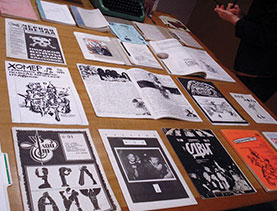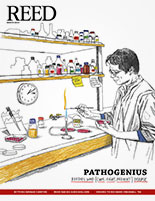
IRIS login | Reed College home Volume 92, No. 1: March 2013
Postcard from Washington, D.C.
By Kristin Williams ’07

Zines of dissent, an archive of samizdat materials from the Soviet bloc at George Washington University’s Gelman Library.
“What is this?” Sophie Mayer ’11 asked as she struggled to make a connection between a postcard with the chemical structure for haloperidol and the Cold War cultural artifacts displayed in front of her. Haloperidol, an antipsychotic used to treat schizophrenia, was employed by the Soviet regime in punitive psychiatry. The postcard was part of Baltimore’s Smoloskyp Publishing House effort to draw attention to Soviet dissenters and to the brutality of psychiatric abuse.
Alumni get-togethers often come in the form of networking, sporting, and fundraising events. But the D.C. chapter opted for something a little different in September—a guided view of the samizdat materials at George Washington University’s Gelman Library. Samizdat comes from truncating the Russian самсебяиздатъ, meaning “I published myself,” in contrast to officially sanctioned publishing houses. At the heart of the collection are materials created, published, and distributed through informal political, religious, and cultural circles.
Our group explored two archives. The first held essentially political materials: letters of protest, trial transcripts, descriptions of arrest, human-rights observance, and descriptions of confinement. Curator Mark Yoffe referred to this as “classic samizdat.” The second featured “zines” (self-published magazines) and extensive holdings of historical recordings of Soviet bard and rock music. Together the two collections illustrate the breadth of the dissident movement.
Samizdat branched out into several manifestations. Magnitizdat derives from magnetic tape and was mostly produced on homemade LPs made from x-ray plates, on pirated LP discs, reel-to-reel tape, and cassettes. Underground music and poetry readings became the samizdat of performing art. There was artistic samizdat, created in a variety of artistic media from drawings and cartoons to photography, oil paintings, sculpture, and installations. Underground exhibits became the samizdat of curatorial art. There were also samizdat lectures, symposia, readings, and recitals.
Samizdat became an industry. Though political samizdat was usually provided free, other material—translations, music, art—carried a price. There was a significant black market for samizdat recordings of Western bands.
Alumni were full of questions. Freya De Cola ’67 admitted that the lecture challenged her association of samizdat with literature and asked how the movement fit with analogous movements happening worldwide. Paul Levy ’72 delved into questions about how Radio Free Europe/Radio Liberty verified documents that came through their archive. James Meador ’09 impressed the crowd with his familiarity with obscure pieces in the collection relating to Soviet Buddhology. James wrote his senior thesis on the topic and pressed Yoffe for a more nuanced explanation of the cacophony of voices found in samizdat. Yoffe discussed the tensions between the groups represented in the archives. He emphasized that the samizdat method gave expression to divergent agendas and was adopted by groups that disliked one another outright.
The evening was topped off with Georgian food and wine as we mingled by a display telling the story of two prominent dissidents—Yuly Daniel and Andrei Siniavsky—whose trial marked a turn in the life of samizdat. During bursts of chatter between bites, stories of Reedies’ archival processing and researching at the Moscow archive Memorial, and thoughts on the recently sentenced Russian punk band Pussy Riot made their way into conversation.


LATEST COMMENTS
steve-jobs-1976 I knew Steve Jobs when he was on the second floor of Quincy. (Fall...
Utnapishtim - 2 weeks ago
Prof. Mason Drukman [political science 1964–70] This is gold, pure gold. God bless, Prof. Drukman.
puredog - 1 month ago
virginia-davis-1965 Such a good friend & compatriot in the day of Satyricon...
czarchasm - 4 months ago
John Peara Baba 1990 John died of a broken heart from losing his mom and then his...
kodachrome - 7 months ago
Carol Sawyer 1962 Who wrote this obit? I'm writing something about Carol Sawyer...
MsLaurie Pepper - 8 months ago
William W. Wissman MAT 1969 ...and THREE sisters. Sabra, the oldest, Mary, the middle, and...
riclf - 10 months ago